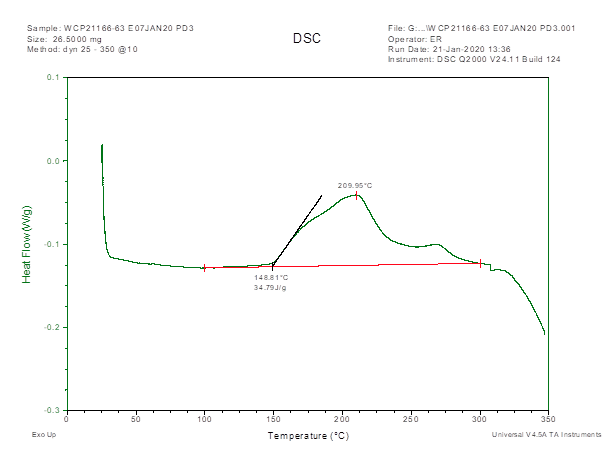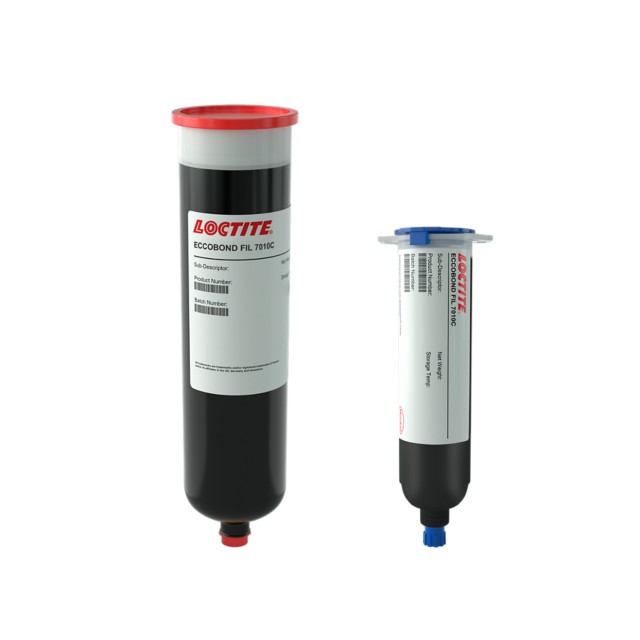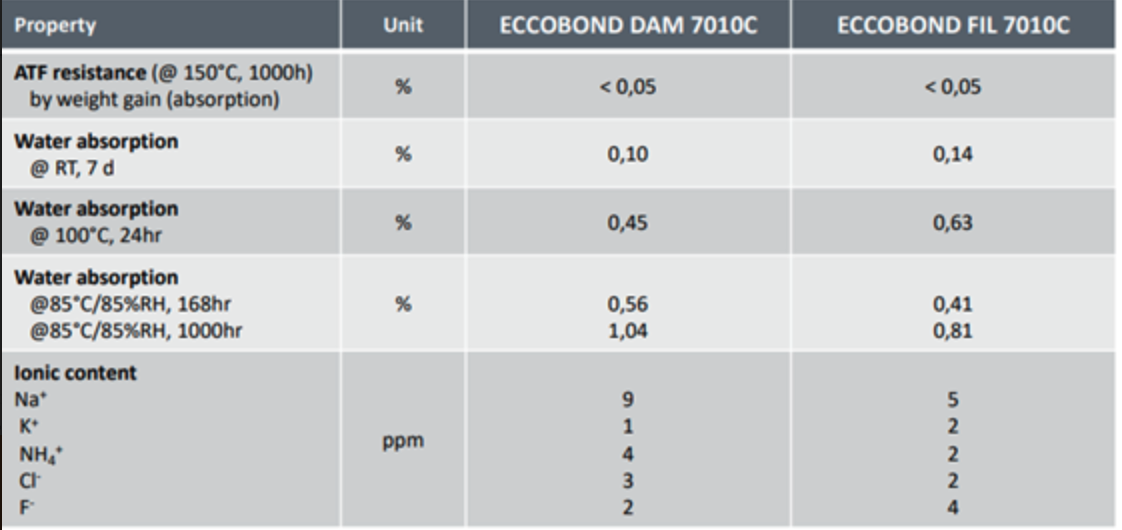LOCTITE ECCOBOND 7010C FIL
- Fill Encapsulant
- Low CTE
- High purity
Product Description
LOCTITE ECCOBOND FIL 7010C is a low viscosity, one component, SVHC free, epoxy product designed for use as a potting or encapsulation resin protection for stress sensitive electronic components. It is specially formulated with a low thermal expansion and high Tg, along with a toughened polymer backbone making it ideally suited to survive severe thermal shock conditions with a high resistance to micro cracking.
LOCTITE ECCOBOND FIL 7010C is a REACH compliant product, designed to survive constant service temperatures of 150°C, with peak temperatures of up to 180°C for chip on board encapsulation.
Cure Schedule
- 2 hours @ 140°C
- 1 hour @ 100°C plus 1 hour @ 150°C (Low Stress)
Technical Specifications
| General Properties | |||||||||
| |||||||||
| Physical Properties | |||||||||
| Viscosity Viscosity Viscosity is a measurement of a fluid’s resistance to flow. Viscosity is commonly measured in centiPoise (cP). One cP is defined as the viscosity of water and all other viscosities are derived from this base. MPa is another common unit with a 1:1 conversion to cP. A product like honey would have a much higher viscosity -around 10,000 cPs- compared to water. As a result, honey would flow much slower out of a tipped glass than water would. The viscosity of a material can be decreased with an increase in temperature in order to better suit an application | 25,000 mPa.s | ||||||||
| Chemical Properties | |||||||||
| |||||||||
| Mechanical Properties | |||||||||
| |||||||||
| Electrical Properties | |||||||||
| Volume Resistivity Volume Resistivity Volume resistivity, also called volume resistance, bulk resistance or bulk resistivity is a thickness dependent measurement of the resistivity of a material perpendicular to the plane of the surface. | 9.6x1015 Ohms⋅cm | ||||||||
| Thermal Properties | |||||||||
| |||||||||
| Glass Transition Temperature (Tg) Glass Transition Temperature (Tg) The glass transition temperature for organic adhesives is a temperature region where the polymers change from glassy and brittle to soft and rubbery. Increasing the temperature further continues the softening process as the viscosity drops too. Temperatures between the glass transition temperature and below the decomposition point of the adhesive are the best region for bonding. The glass-transition temperature Tg of a material characterizes the range of temperatures over which this glass transition occurs. | 160 °C | ||||||||
| Specific Heat Capacity Specific Heat Capacity Specific heat capacity is the amount of heat energy required to raise the temperature of a substance per unit of mass. The specific heat capacity of a material is a physical property. It is also an example of an extensive property since its value is proportional to the size of the system being examined. | 0.79 J/(g⋅°C) | ||||||||
| Thermal Conductivity Thermal Conductivity Thermal conductivity describes the ability of a material to conduct heat. It is required by power packages in order to dissipate heat and maintain stable electrical performance. Thermal conductivity units are [W/(m K)] in the SI system and [Btu/(hr ft °F)] in the Imperial system. | 0.72 W/m.K | ||||||||
Additional Information
Why is FIL7010C considered a "Green" product compared to FP4470?
As you can imagine, the formulations of FP4470 and FIL7010C are different.
FP4470 contains a substance of very high concern "Hexahydromethylphthalic anhydride" (CAS no. 25550-51-0) which is used as an epoxy hardener.
The SVHC list is determined based on the dangers and concerns on an individual substance/molecule basis.
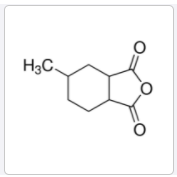
Hexahydromethylphthalic anhydride (CAS no. 25550-51-0)
The FIL7010C formulation does NOT currently contain any substances on the SVHC list and that is why it is considered a less harmful formulation.
For the Chemistry enthusiasts, the epoxy hardener part in the FIL7010C formulation is similar, but still completely different.
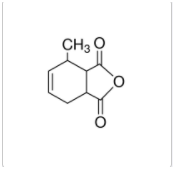
Methyltetrahydrophthalic anhydride (CAS No. 11070-44-3).
Directions for use
- Cure the product per the cure schedule mentioned in the Typical Cure Schedule section of the document.
- The surfaces on which the adhesive has to be applied should be clean, dry and free from all dust.
- Initially dispense LOCTITE ECCOBOND FIL 7010C on the outline of the glob referred to as the "dam".
- The dam is then filled in with LOCTITE ECCOBOND FIL 7010C material.
- Both materials can be co-cured after dispense.
For the low stress schedule we need to point out that according to the DSC curve the cure reaction barely starts at 100-125C. Yes, it happens and yes it is a low stress alternative but given the oven temperature tolerances, batch to batch variations etc we always run the risk of inconsistent results. You should always develop a process that works for your application but for repeatable and predictable results we recommend curing at least at 140°C.
Alternative schedules that could reduce warpage are:
- Gelling temp to 150C and run basically straight 2 hours 150C, and or
- Gelling temp to 150C for 30min followed by 1.5 hours at 160C, and or
- Simply run a straight 2 hours 160C
